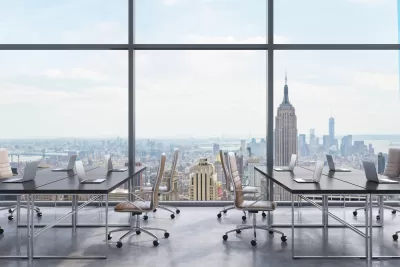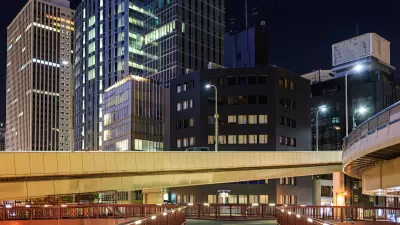Converting office buildings to housing is almost always possible, but, thanks in part to design changes in newer office buildings, it can often be cost-prohibitive.

As many office buildings in urban cores remain vacant post-pandemic, the call to convert them into housing or other uses, a process known as adaptive reuse, has grown louder. But as Emily Badger and Larry Buchanan explain in The New York Times, “The idea, however, is less like a sweeping fix and more like a set of intricate puzzles — a different one for each building.”
To illustrate how conversions can work, and why they’re more effective in older buildings, the authors describe two New York City buildings, one pre-war and one built 40 years later. Older office buildings “make for simpler conversions because the same logic that shaped how they were designed as offices a century ago determines how apartments are planned today. Both share a rule of thumb that no interior space be more than 25 to 30 feet from a window that opens.”
Additionally, older buildings have operable windows and are by and large more affordable than newer office towers. “It’s an elegant circle of city life: The very qualities that have made these buildings outdated as offices now make them ideal candidates for apartments.” In more modern times, the invention of air conditioning and the fluorescent light bulb made it so that offices were no longer constrained to the same needs as before. Buildings could have deeper floor plates, creating more spaces that are far from any natural lighting. Meanwhile, modern office windows that don’t open would have to be replaced at great expense.
Ultimately, the authors write, “Developers and architects who’ve been doing this niche work for years say that few conversions are physically impossible if you’re creative enough.” But cities must create economic incentives to make the process cost-effective. “Such changes would not single-handedly solve any city’s housing woes, or fill all of its office vacancies. But both problems ultimately require more than one fix anyway.” Plans like New York Mayor Eric Adams' proposal to simplify the process for office conversions could yield tens of thousands of new housing units.
FULL STORY: So You Want to Turn an Office Building Into a Home?

Manufactured Crisis: Losing the Nation’s Largest Source of Unsubsidized Affordable Housing
Manufactured housing communities have long been an affordable housing option for millions of people living in the U.S., but that affordability is disappearing rapidly. How did we get here?

Americans May Be Stuck — But Why?
Americans are moving a lot less than they once did, and that is a problem. While Yoni Applebaum, in his highly-publicized article Stuck, gets the reasons badly wrong, it's still important to ask: why are we moving so much less than before?

Using Old Oil and Gas Wells for Green Energy Storage
Penn State researchers have found that repurposing abandoned oil and gas wells for geothermal-assisted compressed-air energy storage can boost efficiency, reduce environmental risks, and support clean energy and job transitions.

Updating LA’s Tree Rules Could Bring More Shade to Underserved Neighborhoods
A new USC study finds that relaxing Los Angeles’ outdated tree planting guidelines could significantly expand urban tree canopy and reduce shade disparities in lower-income neighborhoods, though infrastructure investments are also needed.

California's Canal Solar Projects Aim to Conserve Resources and Expand Clean Energy
California’s Project Nexus has begun generating electricity from solar panels installed over irrigation canals, with researchers and state agencies exploring statewide expansion to conserve water and boost clean energy production.

HHS Staff Cuts Gut Energy Assistance Program
The full staff of a federal program that distributes heating and cooling assistance for low-income families was laid off, jeopardizing the program’s operations.
Urban Design for Planners 1: Software Tools
This six-course series explores essential urban design concepts using open source software and equips planners with the tools they need to participate fully in the urban design process.
Planning for Universal Design
Learn the tools for implementing Universal Design in planning regulations.
Heyer Gruel & Associates PA
City of Moreno Valley
Institute for Housing and Urban Development Studies (IHS)
City of Grandview
Harvard GSD Executive Education
Salt Lake City
NYU Wagner Graduate School of Public Service
City of Cambridge, Maryland





























